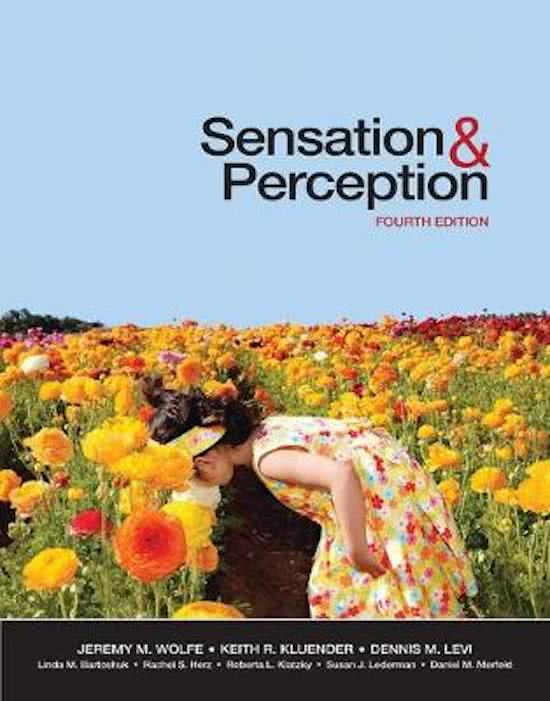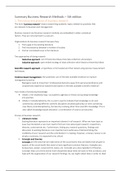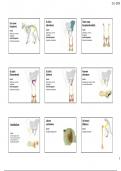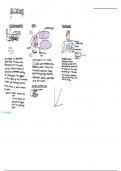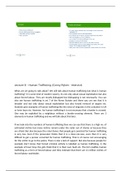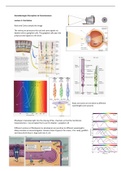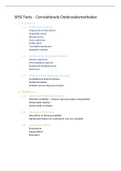Chapter 8: Visual Motion Perception
11 – 3 – 2015
Motion: change in an object’s location over time. It’s a low-level perceptual
phenomenon.
“waterfall illusion” provides evidence that there is something special about
motion: When we look for a long time to the waterfall, the detectors sensitive to
downward motion become adapted. The neurons sensitive to upward motion fire
faster than the tuckered-out downward-sensitive neurons, and we perceive the
rocks as drifting up.
Motion aftereffect (MAE): the illusion of motion of a stationary object that
occurs after prolonged exposure to a moving object.
Simple “bug” motion detector: by Werner Reichardt.
1. A and B are detectors which give an excitatory signal to a D cell and a X cell
2. D fires when it is activated by A. It has an fast adaption rate (cell A detects
light, D fires, but stops firing if the light remains shining on A’s receptive
field)
3. B and D are connected to X: multiplication cell fires when both B
and D are active.
4. By delaying receptors A’s response (D) and multiply it by receptor
B’s response (X), we can create a mechanism that is sensitive for
motion M
This mechanism would be direction-selective: it respond to motion left to right,
but not right to left.
Apparent motion: The illusory impression of smooth motion resulting from the
rapid alternation of objects that appear in different locations in rapid succession.
Frames shown to us at a sufficiently fast speed (60 frames/second) we
perceive these position change over time as motion.
Correspondence problem: in motion detection, the problem faced by the
motion detection system of knowing which feature in frame corresponds to a
particular feature in frame 1.
Aperture problem: the fact that when a moving object is viewed through an
aperture (or a receptive field), the direction of motion of a local feature or part of
the object may be ambiguous.
Aperture: an opening that allows only a partial view of an object.
None of the v1 cells can tell with certainty which visual elements correspond to
one another when an object moves, even when no mask is present. So, have
another set of neurons listen to the V1 neurons and integrate the potentially
conflicting signals.
Middle temporal area (MT): area of the brain thought to be important in the
perception of motion.
- Information from magnocellular neurons feeds into V1 and is then passed
on to MT.
Newsome and Pare’s stimulate a direction sensitive set of neurons in the MT and
showed moving dots. The monkeys’ report motion in the stimulated neurons’
preferred direction, even when the dots they seeing were actually moving in the
opposite direction.
Interocular transfer: the transfer of an effect (such as adaptation) from one
eye to the other.
Motion alter effects are due to a population imbalance in area MT. MEA can occur
even after very brief exposure, 25ms, and can be explained by direction-selective
responses of neurons in MT to subsequently presented stationary stimuli.
1
, First-order motion: the motion of an object that is defined by changes in
luminance.
Luminance-defined object: an object that is delineated by differences in
reflected light.
Second-order motion: the motion of an object that is defined by changes in
contrast or texture, but not by luminance.
Texture-defined object or contrast-defined object: an object that is defined
by differences in contrast, or texture, but not by luminance.
The visual system includes specialized mechanisms for second-order motion. So,
there is a double dissociation between second-order and first-order motion
perception.
As in first-order apparent-motion displays (frames/second), nothing actually
moves in second-order motion. In second-order motion there is nothing to move
changes of strips of dots that are inverted from one frame to another.
Optic array: the collection of light rays that interact with objects in the world
that are in front of a viewer. Term coined by J. J. Gibson (p. 247)
Optic flow: The changing angular positions of points in a perspective image that
we experience as we move through the world. (p. 247)
Focus of expansion: The point in the center of the horizon from which, when
we’re in motion (e.g. driving on the highway), all points in the perspective image
seem to emanate. The focus of expansion is one aspect of optic flow.
Biological motion: The pattern of movement of living beings (humans and
animals).
- Dot walker when lights attached to a moving human are viewed in total
darkness.
- Biological motion plays an important role in how we understand human
actions.
Time to collision (TTC): the time required for a moving object (such as a cricket
ball) to hit a stationary object (such as a batsman’s head). TTC = distance/rate
Tau ( τ ): Information in the optic flow that could signal time to collision (TTC)
without the necessity of estimating either absolute distances or rates. The ratio
of the retinal image size at any moment to the rate at which the image is
expanding is tau, and TTX is proportional to tau.
When our eyes move, the image on the retina moves too.
Smooth pursuit: A type of voluntary eye movement in which the eyes move
smoothly to follow a moving object.
The retinal image movement as you move a pencil while keeping your
gaze centered on a dot is essentially the same as the retinal image
movement of a dot when you keep your gaze centered on the moving
pencil.
Why do we perceive motion of the pencil in first case, but stationary of the dot in
the second?
- In one case there is an eye movement.
Superior colliculus: A structure in the midbrain that is important in initiating
and guiding eye movements.
There are six muscles attached to each eye:
1. Superior oblique 3. Medial rectus. 5. Inferior rectus
2. Superior rectus 4. Lateral rectus 6. Inferior oblique
7. Microsaccade: an involuntary, small, jerklike eye movement.
- Important for very fine spatial judgments (threading a needle)
8. There are 3 types of voluntary eye movements:
1. Smooth eye movements
2


